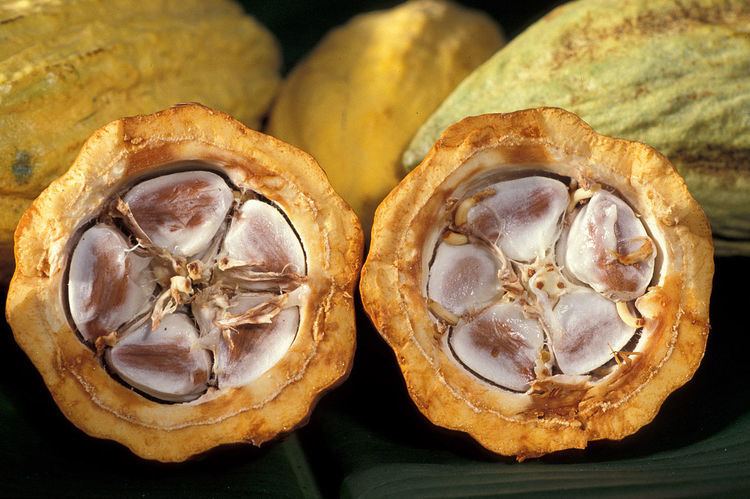World total 4.928 | ||
 | ||
Ivory Coast (Côte d'Ivoire) leads the world in production and export of the cocoa beans used in the manufacture of chocolate, as of 2012, supplying 33% of cocoa produced in the world. West Africa collectively supplies two thirds of the world's cocoa crop, with Ivory Coast leading production at 1.65 million tonnes, and nearby Ghana, Nigeria, Cameroon and Togo producing additional 1.55 million tonnes. Ivory Coast overtook Ghana as the world's leading producer of cocoa beans in 1978. The primary non-African competitor of Ivory Coast is Indonesia, which went from having almost nonexistent domestic cocoa industry in the 1970s to becoming one of the largest producers in the market by the early 2000s. According to the UN FAO, Indonesia overtook Ghana and became the second-largest producer worldwide in 2006. (World Cocoa Foundation provides significantly lower figures for Indonesia, but concurs that it is the largest producer of cocoa beans outside West Africa.) Large chocolate producers such as Cadbury, Hershey's, and Nestle buy Ivorian cocoa futures and options through Euronext whereby world prices are set.
Contents
The plant
Cocoa is shade-loving tree native to the understory of rainforests, growing at low elevation in the foothills of the Andes, and the great South American equatorial river basins the Amazon River Basin, and the Orinoco River Basin. The tree is a choice crop for areas of West Africa with low to slight elevations, good soils, and the constant humidity of the tropics.
Farming and production
The crop is grown in Ivory Coast mostly by smallholder farmers planting on 1-3 hectares. The pods containing the beans are harvested when a sufficient number are ripe, opened to separate the seeds and pulp from the outer rind, and the seeds and pulp are usually allowed to ferment somewhere on the farm, before the seeds are dried in a central location. The dried seeds are purchased by a traitant or buyer who travels among villages in an area to weigh, purchase and collect the crop. The traitant then takes the crop to a short-holding warehouse in a major town or city where the major exporters purchase the seeds and arrange for its export from Ivory Coast. The entire process requires the labored contribution of a variety of workers, from the farmer who owns the fields, to his laborers who may be slaves (non confirmed allegation) and include family members, to others in the village who harvest pods to ferment seeds at the same time, to the local buyers, and the middlemen between these purchasers and the exporters who finally get the crop to an export ship.
Slave labour
Ivory Coast and other West African cocoa producing nations have come under severe criticism in the west for using child slave labor to produce the cocoa purchased by Western chocolate companies. The bulk of the criticism has been directed towards practices in Ivory Coast. The report "A Taste of Slavery: How Your Chocolate May be Tainted" claims that traffickers promise paid work, housing, and education to children who are then forced to labour and undergo severe abuse, that some children are held forcibly on farms and work up to 100 hours per week, and that attempted escapees are beaten. A BBC article claimed that 15,000 children from Mali, some under age 11, were working as slaves in cocoa production in Ivory Coast, and Mali's Save the Children Fund director described "young children carrying 6kg of cocoa sacks so heavy that they have wounds all over their shoulders." In 2001 Chocolate Manufacturers Association acknowledged that slaves harvested some cocoa. In 2013, the U.S. DOL's report Findings on the Worst Forms of Child Labor in Côte d'Ivoire stated that 39.8% of children aged 5 to 14 are working children and that they "are engaged in the worst forms of child labor in agriculture, particularly on cocoa farms, sometimes under conditions of forced labor." In December 2014, the DOL's List of Goods Produced by Child Labor or Forced Labor mentioned Ivory Coast among the countries where instances of such working conditions (both child labor and forced labor) are still observed.
